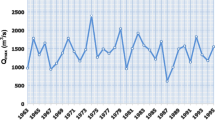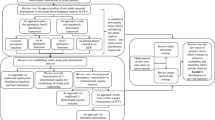Abstract
Consideration of a broad range of hydrological loads is essential for risk-based flood protection planning. Furthermore, in the planning process of technical retention facilities it is necessary to use flood events, which are specified by several characteristics (peak, volume and shape). Multivariate statistical methods are required for their probabilistic evaluation. Coupled stochastic-deterministic simulation may be applied to generate a runoff time series, since the required amount of data is generally not available. Even the effect of complex flood protection systems may be evaluated through generation of a data base by means of stochastic-deterministic simulations with subsequent statistical analysis of the individual hydrological load scenarios. Multivariate frequency analyses of correlated random variables are useful to specify these scenarios statistically. Copulas are a very flexible method to estimate multivariate distributions, because the marginal distributions of the random variables can differ. Here a methodology for flood risk assessment is presented which was applied in two case studies in Germany.
Access this chapter
Tax calculation will be finalised at checkout
Purchases are for personal use only
Similar content being viewed by others
References
Akaike H (1974) A new look at statistical model identification. IEEE Trans Automatic Control AC19(6):716–723
Bergmann H, Sackl B (1989) Determination of design flood hydrographs based on regional hydrological data. In: Kavvas ML (ed) New directions for surface water modelling. IAHS Publ. no. 181, Wallingford
Blazkova S, Beven K (2004) Flood frequency estimation by continuous simulation of subcatchment rainfalls and discharges with the aim of improving dam safety assessment in a large basin in the Czech Republic. J Hydrol 292(1–4):153–172
Cherubini U, Luciano E, Vecchiato W (2004) Copula methods in finance. Wiley, Chichester
Deheuvels P (1979) Empirical dependence function and properties – nonparametric test of independence. Bull De La Classe Des Sci Acad R De Belg 65(6):274–292
De Michele C, Salvadori G (2003) A generalized pareto intensity-duration model of storm rainfall exploiting 2-Copulas. J Geophys Res Atmospheres 108(D2):ACL 15–1
De Michele C, Salvadori G, Canossi M, Petaccia A, Rosso R (2005) Bivariate statistical approach to check adequacy of dam spillway. J Hydrol Eng 10(1):50–57
Embrechts P, Lindskog F, McNeil AJ (2003) Modelling dependence with copulas and applications to risk management. In: Rachev ST (ed) Handbook of heavy tailed distributions in finance. Elsevier, North-Holland, Amsterdam
Evin G, Favre AC (2008) A new rainfall model based on the Neyman-Scott process using cubic copulas. Water Resour Res 44(3):1–18
Favre AC, El Adlouni S, Perreault L, Thiemonge N, Bobee B (2004) Multivariate hydrological frequency analysis using copulas. Water Resour Res 40(1):1–12
Genest C, Favre AC (2007) Everything you always wanted to know about copula modeling but were afraid to ask. J Hydrologic Eng 12(4):347–368
Genest C, Remillard B (2008) Validity of the parametric bootstrap for goodness-of-fit testing in semiparametric models. Annales de l’Institut Henri Poincaré – Probabilités et Statistique 44(6):1096–1127
Genest C, Rivest LP (1993) Statistical-Inference procedures for Bivariate Archimedean Copulas. J Am Stat Assoc 88(423):1034–1043
Genest C, Quessy JF, Remillard B (2006) Goodness-of-fit procedures for copula models based on the probability integral transformation. Scand J Stat 33(2):337–366
Genest C, Remillard B, Beaudoin D (2009) Goodness-of-fit tests for copulas: a review and a power study. Insur Math Econ 44(2):199–213
Goel NK, Seth SM, Chandra S (1998) Multivariate modeling of flood flows. J Hydraulic Eng 124(2):146–155
Grimaldi S, Serinaldi F (2006a) Design hyetograph analysis with 3-copula function. Hydrol Sci J-J Des Sci Hydrologiques 51(2):223–238
Grimaldi S, Serinaldi F (2006b) Asymmetric copula in multivariate flood frequency analysis. Adv Water Resour 29(8):1155–1167
Haberlandt U, Ebner von Eschenbach AD, Buchwald I (2008) A space-time hybrid hourly rainfall model for derived flood frequency analysis. Hydrol Earth Syst Sci 12(6):1353–1367
Hiemstra LAV, Zucchini WS, Pegram GGS (1976) Method of finding family of runhydrographs for given return periods. J Hydrol 30(1–2):95–103
Hosking JRM, Wallis JR (1997) Regional frequency analysis: an approach based on L-moments. Cambridge University Press, Cambridge
Hundecha Y, Pahlow M, Klein B, Schumann A (2008) Development and test of a stochastic rainfall generator for the generation of hydrologic load scenarios (in German). Forum für Hydrologie und Wasserwirtschaft, Heft 23.06, Beiträge zum Tag der Hydrologie 2008, Hannover, pp 34–41
Hundecha Y, Pahlow M, Schumann A (2009) Modeling of daily precipitation at multiple locations using a mixture of distributions to characterize the extremes. Water Resour Res 45(W12412):1–15
Hydrotec (2007) Niederschlags-Abfluss-Modell – NASIM – Version 3.6.0. Programmdokumentation. Hydrotec Ingenieurgesellschaft für Wasser und Umwelt mbH, Aachen
Joe H (1997) Multivariate models and dependence concepts. Chapman and Hall, New York
Kao SC, Govindaraju RS (2008) Trivariate statistical analysis of extreme rainfall events via the Plackett family of copulas. Water Resour Res 44(2):1–19
Karmakar S, Simonovic SP (2008) Bivariate flood frequency analysis: Part 1. Determination of marginals by parametric and nonparametric techniques. J Flood Risk Manag 1:190–200
Karmakar S, Simonovic SP (2009) Bivariate flood frequency analysis. Part 2: a copula-based approach with mixed marginal distributions. J Flood Risk Manag 2:32–44
Kim G, Silvapulle MJ, Silvapulle P (2007) Comparison of semiparametric and parametric methods for estimating copulas. Comput Stat Data Anal 51(6):2836–2850
Klein B, Schumann A (2006) Generation of multi-peak hydrographs for the flood design of dams (in German). Forum für Hydrologie und Wasserwirtschaft, Heft 15.06, Beiträge zum Tag der Hydrologie 2006, Band 2, München, pp 255–266
Klein B, Pahlow M, Hundecha Y, Schumann A (2010) Probability analysis of hydrological loads for the design of flood control systems using copulas. J Hydrol Eng 15(5). doi: 10.1061/(ASCE)HE.1943-5584.0000204
Koutsoyiannis D (2001) Coupling stochastic models of different time scales. Water Resour Res 37(2):379–392
Koutsoyiannis D, Onof C, Wheater HS (2003) Multivariate rainfall disaggregation at a fine timescale. Water Resour Res 39(7):1–18
Lindström G, Johansson B, Persson M, Gardelin M, Bergström S (1997) Development and test of the distributed HBV-96 hydrological model. J Hydrol 201(1–4):272–288
Nelsen RB (1999) An introduction to copulas. Springer, New York, NY
Nijssen D, Schumann A, Pahlow M, Klein B (2009) Planning of technical flood retention measures in large river basins under consideration of imprecise probabilities of multivariate hydrological loads. Nat Hazards Earth Syst Sci 9(4):1349–1363
Petry U, Hundecha Y, Pahlow M, Schumann A (2008) Generation of severe flood scenarios by stochastic rainfall in combination with a rainfall runoff model. Proceedings of the 4th International Symposium on Flood Defense, 6–8 May, Toronto, ON
Renard B, Lang M (2006) Use of a Gaussian copula for multivariate extreme value analysis: Some case studies in hydrology. Adv Water Resour 30(4):897–912
Salvadori G, De Michele C (2004) Frequency analysis via copulas: theoretical aspects and applications to hydrological events. Water Resour Res 40(12):1–17
Salvadori G, De Michele C (2006) Statistical characterization of temporal structure of storms. Adv Water Resour 29(6):827–842
Salvadori G, De Michele C (2007) On the use of copulas in hydrology: theory and practice. J Hydrol Eng 12(4):369–380
Salvadori G, De Michele C, Kottegoda NT, Rosso R (2007) Extremes in nature: an approach using copulas. Series: Water Science and Technology Library, vol 56. Springer, Dordrecht
Sandoval CE, Raynal-Villasenor J (2008) Trivariate generalized extreme value distribution in flood frequency analysis. Hydrol Sci J-J Des Sci Hydrologiques 53(3):550–567
Saunders R, Laud P (1980) The multidimensional kolmogorov goodness-of-fit test. Biometrika 67(1):237–237
Schumann A (2009) Abschlussbericht des BMBF-Verbundforschungsvorhabens “Integrative Nutzung des technischen Hochwasserrückhalts in Poldern und Talsperren am Beispiel des Flussgebiets der Unstrut”. Schriftenreihe Hydrologie/Wasserwirtschaft Nr. 24, Lehrstuhl für Hydrologie, Wasserwirtschaft und Umwelttechnik, Ruhr-Universität Bochum, Bochum
Schwarz G (1978) Estimating the dimension of a model. Ann Stat 6(2):461–464
Serinaldi F, Grimaldi S (2007) Fully nested 3-copula: procedure and application on hydrological data. J Hydrol Eng 12(4):420–430
Shiau JT (2003) Return period of bivariate distributed extreme hydrological events. Stoch Environ Res Risk Assess 17(1–2):42–57
Shiau JT, Feng S, Nadaraiah S (2007) Assessment of hydrological droughts for the Yellow River, China, using copulas. Hydrol Processes 21(16):2157–2163
Shiau JT, Wang HY, Tsai CT (2006) Bivariate frequency analysis of floods using copulas. J Am Water Resour Assoc 42(6):1549–1564
Singh K, Singh VP (1991) Derivation of bivariate probability density-functions with exponential marginals. Stoch Hydrol Hydraul 5(1):55–68
Sklar A (1959) Fonctions de répartion à n dimensions et leurs marges. Publ Inst Stat Univ Paris 8:220–231
Stedinger JR, Vogel RM, Foufoula-Georgiou E (1993) Frequency analysis of extreme events. In: Maidment DR (ed) Handbook of hydrology. McGraw-Hill, New York, NY
Whelan N (2004) Sampling from Archimedean copulas. Quant Finance 4(3):339–352
Yue S (1999) Applying bivariate normal distribution to flood frequency analysis. Water Int 24(3):248–254
Yue S (2001) A bivariate gamma distribution for use in multivariate flood frequency analysis. Hydrol Processes 15(6):1033–1045
Yue S, Ouarda T, Bobee B (2001) A review of bivariate gamma distributions for hydrological application. J Hydrol 246(1–4):1–18
Yue S, Ouarda T, Bobee B, Legendre P, Bruneau P (1999) The Gumbel mixed model for flood frequency analysis. J Hydrol 226(1–2):88–100
Zhang L, Singh VP (2006) Bivariate flood frequency analysis using the copula method. J Hydrol Eng 11(2):150–164
Zhang L, Singh VP (2007a) Bivariate rainfall frequency distributions using Archimedean copulas. J Hydrol 332(1–2):93–109
Zhang L, Singh VP (2007b) Gumbel-Hougaard copula for trivariate rainfall frequency analysis. J Hydrol Eng 12(4):409–419
Zhang L, Singh VP (2007c) Trivariate flood frequency analysis using the Gumbel-Hougaard copula. J Hydrol Eng 12(4):431–439
Author information
Authors and Affiliations
Corresponding author
Editor information
Editors and Affiliations
Rights and permissions
Copyright information
© 2011 Springer Science+Business Media B.V.
About this chapter
Cite this chapter
Klein, B., Schumann, A.H., Pahlow, M. (2011). Copulas – New Risk Assessment Methodology for Dam Safety. In: Schumann, A. (eds) Flood Risk Assessment and Management. Springer, Dordrecht. https://doi.org/10.1007/978-90-481-9917-4_8
Download citation
DOI: https://doi.org/10.1007/978-90-481-9917-4_8
Published:
Publisher Name: Springer, Dordrecht
Print ISBN: 978-90-481-9916-7
Online ISBN: 978-90-481-9917-4
eBook Packages: Earth and Environmental ScienceEarth and Environmental Science (R0)




